Contents
Market Overview
Online bloggers temporarily take over market headlines. Significant de-grossing via Long/Short funds increased market volumes considerably this week. On Wednesday, 23bn shares traded which is the highest cash volume on record and larger than the 19.8bn peak daily volume in October 2008. We also note that the VIX clocked 37.2, when 30-day realized S&P volatility was 13.5, where the spread of 24ppts is the largest in 20 years. However, the bullish point to consider is that the Nasdaq drawdown was 25% in 1998, but finished the year up 40% and more recently the 2020 drawdown was 32% but ended the year up 43%. These events overshadowed the FOMC, even if Powell appeared frustrated in the Q&A session. The 118 companies reporting Full-Year earnings were also side-tracked, perhaps with the exception of American Airlines after a Reddit post. Otherwise initial jobless claims declined to 847k but the trend is still upward and U.S. real GDP of -3.5% confirmed the largest annual decline since 1946. That said, we have a more upbeat 2021 to look forward to after the IMF revised up U.S. growth by 2ppts to 5.1%, but that still trails the top U.S. investment bank forecasts of 6.4%. Nevertheless, EM outperformed DM markets in Credit and ended the week up 0.1% or 2bp wider in spread. Key outperformers include El Salvador, Iraq and Tunisia, while Sri Lanka, Belize and Gabon lagged.
Next week China is due to release FX reserve data, although the focus will be on overnight and 7-day repo levels after the large spike to 5-year highs last week. We can also expect to see rate decisions out of Czech Republic (0.25%), Egypt (8.25%), Ghana (14.5%), Poland (0.1%) and Thailand (0.5%). Then a slew of inflation releases from Colombia, Indonesia, Philippines, Peru, South Korea and Turkey standout.
This week’s emerging markets highlights discussed below include the following: The IMF’s World Economic Outlook points to stronger than anticipated 2021 global growth albeit differentiated and incomplete; Comments by Turkey’s Central Bank Governor confirm that monetary policy will not be eased until there is a sustained drop in inflation and can be tightened further, if necessary; Peru commission approved controversial draft pension overhaul to be discussed in Congress; new lockdown measures imposed; YPF marginally improved its exchange offer; and Global emerging market corporates in focus: Risks from climate action.
Fixed Income
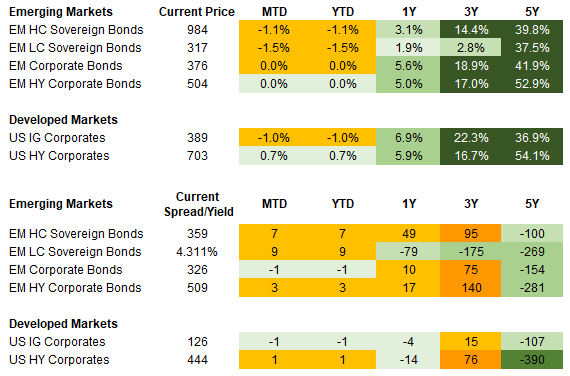
Equities
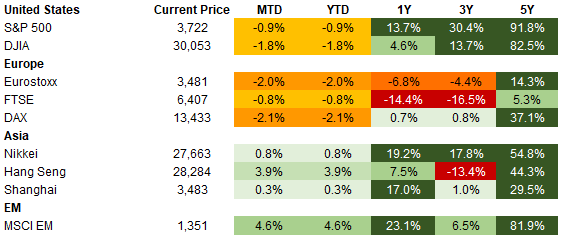
Commodities

Source for data tables: Bloomberg, JPMorgan, Gramercy. EM Fixed Income is represented by the following JPMorgan Indicies: EMBI Global, GBI-EM Global Diversified, CEMBI Broad Diversified and CEMBI Broad High Yield. DM Fixed Income is represented by the JPMorgan JULI Total Return Index and Domestic High Yield Index. Fixed Income, Equity and Commodity data is as of January 29, 2021 (Mid Afternoon).
Emerging Markets Weekly Highlights
The IMF’s World Economic Outlook points to stronger than anticipated 2021 global growth albeit differentiated and incomplete
Event: The IMF revised its 2021 global real GDP forecast up to 5.5% from 5.2% driven by expectations for strengthening of vaccine-related activity as the year progresses as well as additional policy support from major economies. Developed markets growth is expected to be 4.3% compared to emerging markets growth of 6.3%. The bulk of the upward revision stems from the U.S. and Japan as well as India, Brazil and Mexico. Global trade is forecasted to expand by 8% led by merchandise volumes with a lagged recovery in services. The Fund expects inflation to remain subdued in the backdrop of still negative output gaps. The report emphasizes the ‘exceptional uncertainty’ of these assumptions with considerable upside and downside risks dependent on the trajectory of the virus, vaccine effectiveness and distribution, policy, and social conditions.
Gramercy Commentary: The view aligns with our top-down expectations for credit differentiation on continuation of the uneven nature of the recovery across economies, sectors, and companies. While building growth momentum in the U.S. creates potential for incrementally higher UST yields later in the year, we expect fiscal and monetary policy to remain supportive in the backdrop of the still incomplete recovery and moderate inflationary pressures. We expect open manufacturing oriented economies, notably China, to continue to do well in the first half of the year while service oriented economies with solid vaccine rollouts deliver outsized gains later in the year.
Comments by Governor Agbal of Turkey’s Central Bank confirm that monetary policy will not be eased until there is a sustained drop in inflation, and can be tightened further, if necessary
Event: Naci Agbal, Governor of the Central Bank of Turkey (CBRT), used the presentation of CBRT’s quarterly inflation report and outlook this week to deliver another strong and unambiguous signal that monetary policy will remain tight, targeting single digit inflation by year-end.
Gramercy commentary: As we have written extensively recently, a U-turn in policy direction by Turkey’s key economic institutions (i.e. the CBRT and MinFin), which was tacitly endorsed by President Erdogan, materialized in November 2020 illustrated by an aggressive 675 bps of monetary policy tightening over the last three months. Despite this material policy shift, many market participants seem to remain cautious about the “credibility of Turkey’s return to economic orthodoxy”. From that perspective, Governor Agbal’s new series of hawkish comments this week are helpful in the gradual process of rebuilding market confidence. They should also further alleviate lingering investor concerns about potential “pre-mature” monetary policy easing under political pressure. We believe that CBRT’s policy decisions will remain “data-driven” for the foreseeable future and we do not expect any policy easing until a sustained drop in both realized and expected inflation is achieved, which the authorities project will not happen until 3Q 2021. In the meantime, in the event short-term inflation dynamics overshoot to the upside, we expect the CBRT to deliver additional policy tightening in order to maintain a healthy positive onshore real interest rate buffer. In our view, all of this points to a constructive outlook for Turkey’s credit and FX story this year. Still light foreign positioning across Turkish assets leaves room for further rallies on the back of continuation of market-friendly economic policy, which is our base-case expectation. Furthermore, despite the significant TRY appreciation since November, we believe the currency has potential to strengthen further. We see tailwinds on the horizon from de-dollarization of local bank deposits, foreign inflows into Turkish equities and the general economic recovery as domestic and global activity continues to move closer to normalization as the year progresses.
Peru commission approved controversial draft pension overhaul to be discussed in Congress; new lockdown measures imposed
Event: The Pension Reform Committee approved a draft proposal to unify the existing private and public plans into an integrated system with three pillars (universal, contributive, and voluntary) to be managed by an autonomous public entity. It is unclear when this will be discussed in Congress. Meanwhile, health system pressures have led to a reinstatement of a two week stay-at-home order for ten cities.
Gramercy Commentary: The nature of the pension reform is negative for sentiment and boosts uncertainty regarding institutional quality going forward, particularly in the backdrop of the upcoming general election on April 11th. Absent a commitment of additional fiscal resources, the universal minimum pension requirement would likely imply a discount to the public assets transferred into the new system. Furthermore, there could be uncertainty regarding the future freedom of asset allocation under this concentrated system. Given the complex nature of the bill, we expect it to be discussed under the new Congress post-election. The new fairly restrictive COVID-19 measures pose downside risks to consensus growth forecasts of 9% for this year, particularly if the restrictions are extended beyond two weeks. Vaccination contracts for doses of just under 40% of the population suggest that traditional measures will likely remain the main COVID-19 strategy for much of 2021.
YPF marginally improved its exchange offer
Event: This week, YPF announced a modification on its voluntary exchange offer plus exit consent. This second modification follows a first modification that was focused on normalizing some procedural issues. Critically, the new exchange terms improve economics to the benefit of bondholders. The company improved the economic terms of the offer by: (1) enhancing the collateral package of the proposed 26s; (2) modifying the originally proposed grace period with a small interest payment period; and (3) shortening the amortization profile of the new 26s and 29s. The company also lowered the proposed notional on offer for each of the existing series of bonds, thus mitigating some of the economic improvement to bondholders. The company has stated that due to timing constraints / blackout periods, this is the ‘best-and-final’ offer.
Gramercy commentary: The improved economic terms should be welcomed by bondholders as a step in the right direction. However, at this point, the critical issue will be whether the company is able to get threshold participation in the March 2021 Notes.
Global emerging market corporates in focus: Risks from climate action
Events: In the past week, the U.S. has rejoined the Paris Agreement and President Biden has signed an executive order putting climate change at the center of national security and foreign policy. In addition, S&P highlighted risks to oil and gas producers, including energy transition. As a result, ratings assigned to nine oil and gas majors were placed on CreditWatch with negative implications. Later this year, the UK will host the 26th UN Climate Change Conference, a much-anticipated event.
Gramercy commentary: The prevalence of crude oil and other extractive industries deemed to be significant sources of pollutants in emerging markets makes ever-increasing focus on climate change a challenge. For some countries, these exports are the main source of foreign currency. Significant shifts away from fossil fuels will clearly have implications for exporters. Having said this, it is unclear how quickly such changes can be made – climate action has been discussed for some time, after all. Fossil fuels may remain in widespread use for years to come. Supporting this, while many countries already discourage (or even penalize) use of cars powered by crude oil derivatives, governments and others are yet to put in place infrastructures which would allow for more meaningful energy transitions. It is also worth highlighting that some issuers have pre-empted investor concerns by raising funds to specifically finance de-carbonization and/or to back green/environmental projects. Several countries have set net zero emission targets, however. The road to those targets promises to be interesting for emerging markets corporates.
Emerging Markets Technicals
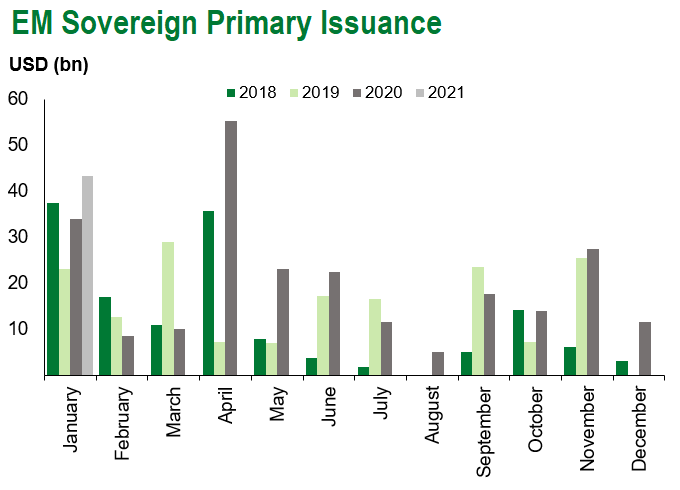
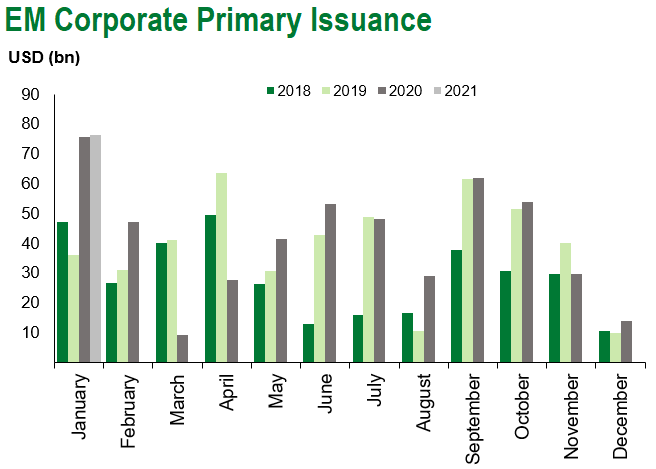
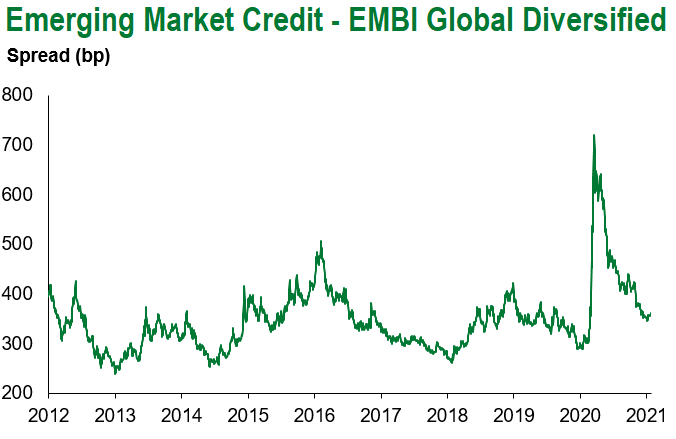
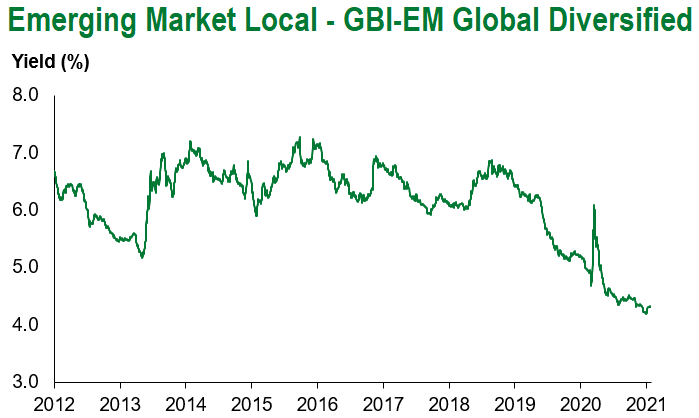
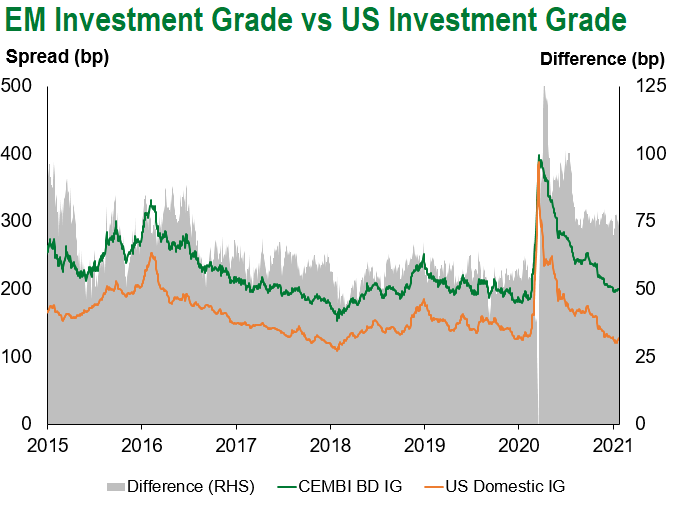
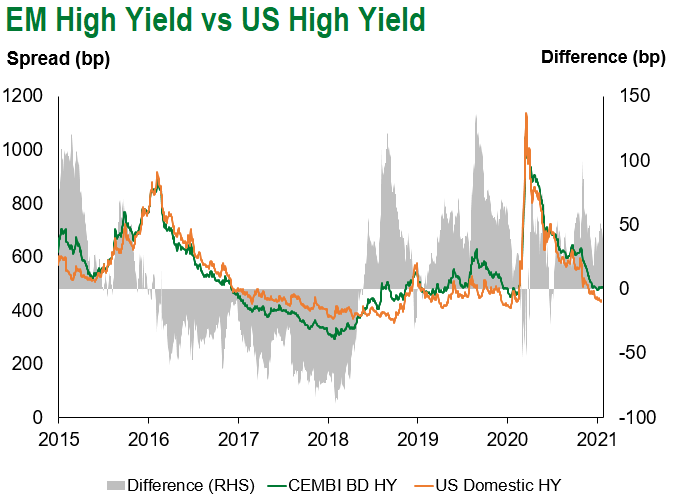
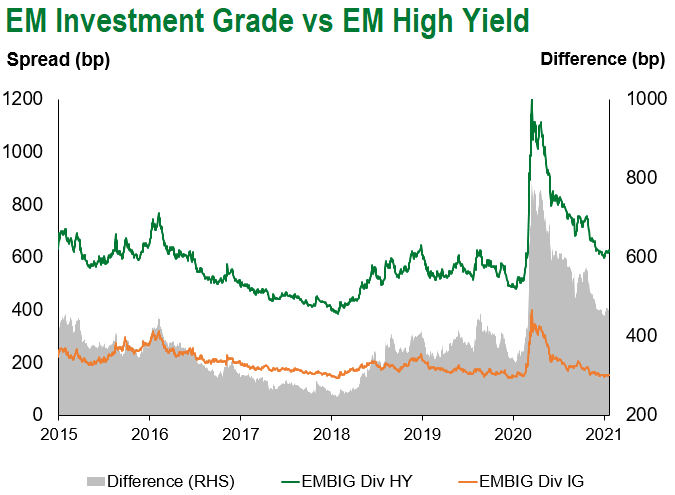
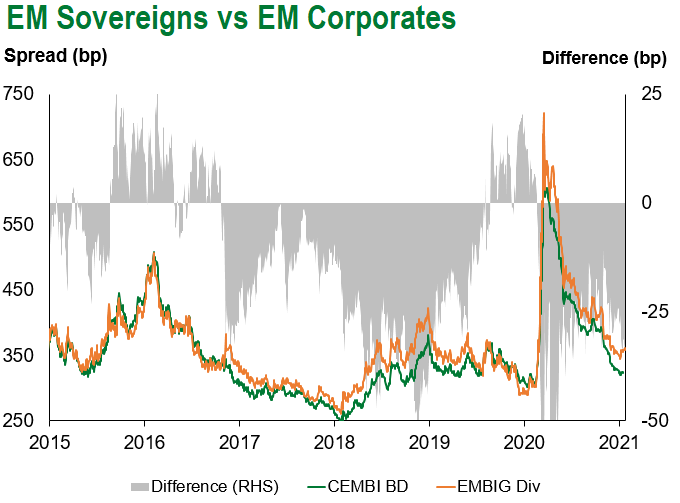
Emerging Markets Flows
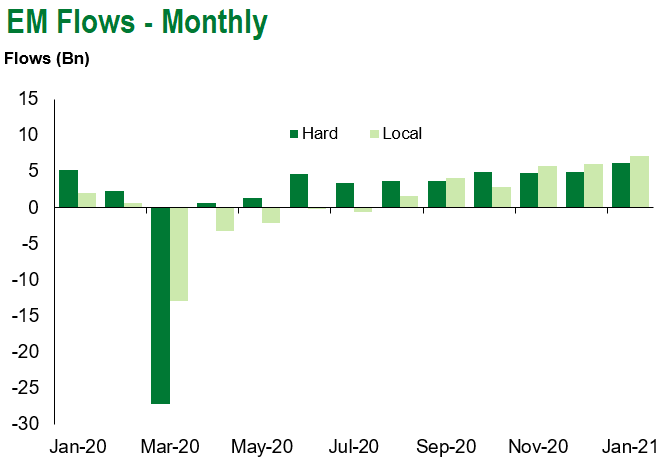
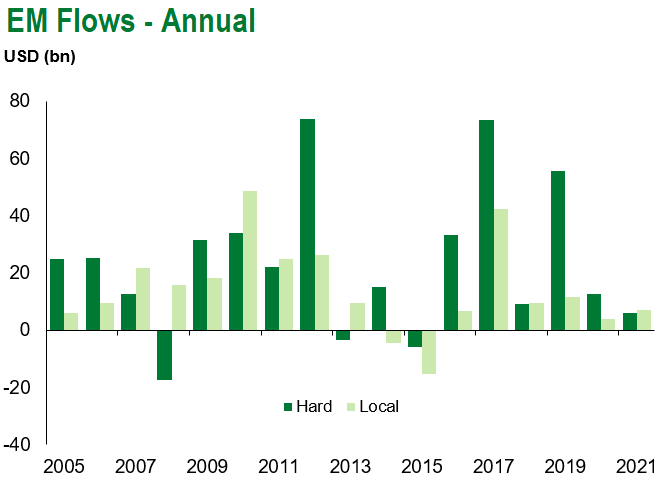
Source for graphs: Bloomberg, JPMorgan, Gramercy. As of January 29, 2021.
COVID Resources
Emerging Markets COVID-19 Case Summary
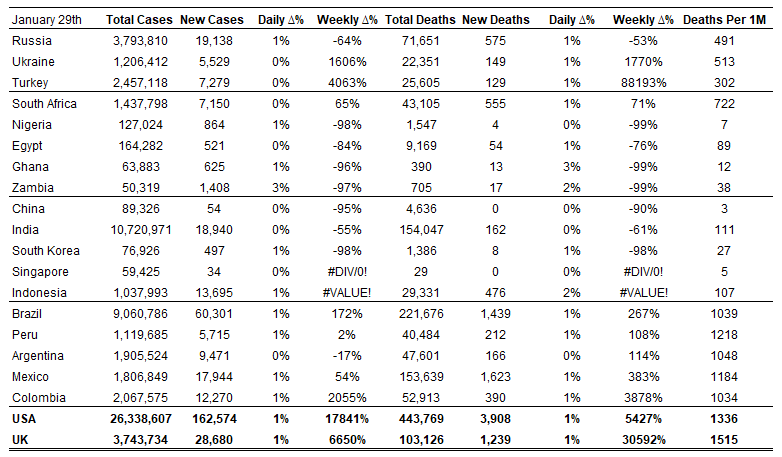
Source: Worldometer as of January 29, 2021.
Additional Crisis Resources:
Johns Hopkins COVID-19 Case Tracker
For questions, please contact:
Kathryn Exum, Senior Vice President, Sovereign Research Analyst, [email protected]
Petar Atanasov, Senior Vice President, Sovereign Research Analyst, [email protected]
Tolu Alamutu,CFA, Senior Vice President, Corporate Research Analyst, [email protected]
James Barry, Vice President, Corporate Research Analyst, [email protected]
This document is for informational purposes only. The information presented is not intended to be relied upon as a forecast, research or investment advice, and is not a recommendation, offer or solicitation to buy or sell any securities or to adopt any investment strategy. Gramercy may have current investment positions in the securities or sovereigns mentioned above. The information and opinions contained in this paper are as of the date of initial publication, derived from proprietary and nonproprietary sources deemed by Gramercy to be reliable, are not necessarily all-inclusive and are not guaranteed as to accuracy. This paper may contain “forward-looking” information that is not purely historical in nature. Such information may include, among other things, projections and forecasts. There is no guarantee that any forecasts made will come to pass. Reliance upon information in this paper is at the sole discretion of the reader. You should not rely on this presentation as the basis upon which to make an investment decision. Investment involves risk. There can be no assurance that investment objectives will be achieved. Investors must be prepared to bear the risk of a total loss of their investment. These risks are often heightened for investments in emerging/developing markets or smaller capital markets. International investing involves risks, including risks related to foreign currency, limited liquidity, less government regulation, and the possibility of substantial volatility due to adverse political, economic or other developments. The information provided herein is neither tax nor legal advice. Investors should speak to their tax professional for specific information regarding their tax situation.